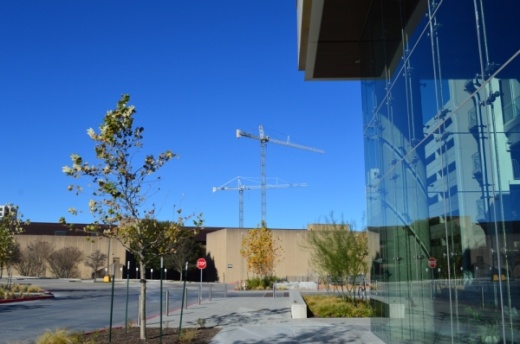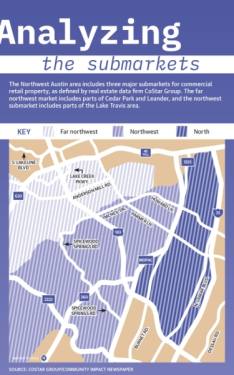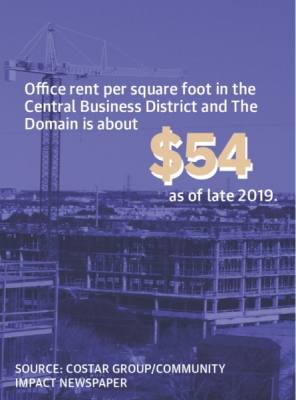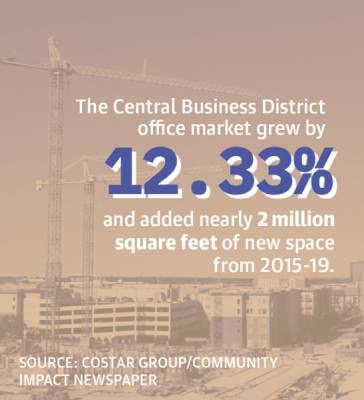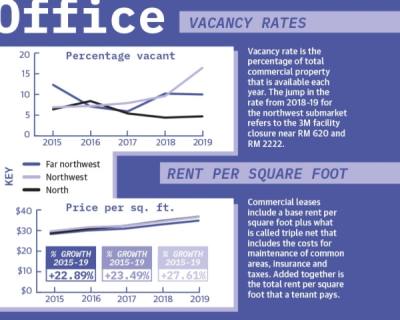Co-owner Beth Selbe Lasita said the decision came down to a lack of sales and slow foot traffic, even in the popular shopping destination.
“We [still] have four very successful restaurants,” she said. “But we were doing half as much in sales [at Domain Northside].”
Selbe Lasita said the owners were initially sold on the location with its outdoor patio shaded by large trees like the other locations.
“We like being in a neighborhood center, something that’s not a big shopping mall, so we’ll be staying away from large developments,” Selbe Lasita said.
For retail businesses, that lack of foot traffic can bea game changer for whether a business will make it.
“You’re really relying on foot traffic unless you have an online [store] presence,” said Nathan Smith, owner of Austin Tenant Advisors, a commercial real estate services company that represents tenants.
Retail details
The Grove’s Domain Northside location is one of more than 40 retail shops and restaurants that closed in 2019 and early 2020 in the Northwest Austin area, according to information gathered by Community Impact Newspaper.
For retail shops, the numerous closings have followed a nationwide trend of shops being unable to compete with Amazon, said Jason Faludi, a partner with Aquila Commercial, an Austin-based commercial real estate firm. Many of the closings in 2019 were national chains, according to Community Impact Newspaper data.
“If you’re not in the services or restaurant game, it’s been a death march for all of them because of Amazon. That’s a national trend, not just Austin,” he said.
When large retail space opens up, that space typically gets repurposed, Faludi said, in one of two ways. That space could be transformed into office space or become occupied by other types of businesses.
“What you’re finding is they’re repurposing big-box space with more service-oriented retail, like a hair salon or nail salon,” he said.
That is exactly what happened to the former Saks Fifth Avenue space in Arboretum Market that closed in December 2012, leaving 52,000 square feet of retail space vacant. In June 2014, Trader Joe’s opened in part of the store, and later a Pottery Barn Kids opened in another part of the space. The last space sat vacant until Austin-based Milk + Honey expanded its salon and added a spa in November.
One example of restaurant-turned-office space is the former Abel’s North restaurant that is now a 24,550-square-foot creative office space. The leasing company, Colliers International, reported in its leasing brochure that rent is $27 per square foot, on par with rates in the area.
For retail shops to do well, Smith said owners need to understand their leases, know how to market their stores and have an online presence.
“National brands in The Domain may not do well, but their presence alone can drive online sales,” Smith said. “Mom-and-pops can’t do that. That one shop is their bread and butter.”
A growing inventory
As Austin continues attracting more new residents and jobs, companies are vying for the limited amount of available office space.
“In general, everywhere in Austin, the inventory continues to go down,” Smith said. “There’s some new [space] being built, but it’s getting harder and harder [to lease space]. There’s more competition for the new stuff.”
Most of those companies can find new Class A office space in the Central Business District, which added nearly 2 million square feet of office space between 2015-19. The other large draw for tenants needing large swaths of office space is The Domain. The mixed-use development is located in the north submarket, which grew 17.08% from 2015-19 to a total of 9.65 million square feet of office space, according to analysis of data from commercial real estate data company CoStar Group.
Smith said most of the Class A office space at The Domain is going for $53-$55 per square foot, which includes what is called triple net. This includes the other expenses the landlord tacks on to the lease: maintaining the common areas, insurance and taxes. These rates at The Domain are on par with rental rates in the Central Business District, which CoStar reported as $54 per square foot in 2019.
At The Domain, Smith said it is not uncommon for new buildings to be completely leased before construction is even finished. VRBO and Amazon both signed leases for almost entire buildings that were still under construction.
“If you’re a small tenant, getting in The Domain is going to be impossible unless somebody wants to sublease the space,” he said.
More space for lease
Even with new space coming online, the northwest submarket took a hit to its vacancy rate when in 2017, 3M Co. sold its 1.3 million-square-foot center in the Four Points area to real estate investment firm World Class Capital Group.
That closing created a more than six-point swing in the area’s office property vacancy rate, bringing it from 9.58% in 2018 to 16.4% in 2019.
CoStar’s director of analytics Sam Tenenbaum said because it was just one building, that upswing can be deceiving.
“You could make a convincing argument that the roughly 1.2 [million] or 1.3 million square feet that building represents is just one building, so you could exclude it [from the data], but the problem with that is if you exclude it today, you have to exclude it back over history, so it really kind of messes with the stats,” he said.
Information gathered from CoStar shows office vacancy rates in the north region steadily increasing from 4.7% in 2019 to 13.4% in 2023 and staying above 14% in the northwest region. This is partly because of a predicted economic downturn that Tenenbaum said is factored into CoStar’s data projections.
“That will happen as we run out of people to hire,” he said. “The unemployment rate in Austin is incredibly low right now. With a slowdown in job growth, that also means a slowdown in the real estate markets across Austin generally.”
Another data set forecast to hold relatively stable in the coming years is rent growth, which is defined by the growth of the average asking commercial rent prices year over year.
In the northwest region, rent growth dropped one percentage point from 5.1% in 2014 to 4.1% in 2018. Although it dropped down to -1.1% in 2019, growth is expected to rise slightly and top out at 1.2% by 2023.
“The rent growth is still positive, which is good, I suppose, if you’re a landlord, but not necessarily if you’re a tenant,” Tenenbaum said.
Additional reporting by Brian Rash



